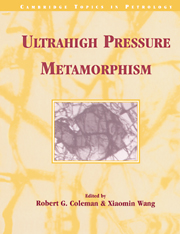Book contents
- Frontmatter
- Contents
- List of contributors
- Preface
- 1 Overview of the geology and tectonics of UHPM
- 2 Experimental and petrogenetic study of UHPM
- 3 Principal mineralogic indicators of UHP in crustal rocks
- 4 Structures in UHPM rocks: A case study from the Alps
- 5 Creation, preservation, and exhumation of UHPM rocks
- 6 The role of serpentinite melanges in the unroofing of UHPM rocks: An example from the Western Alps of Italy
- 7 Ultra-high-pressure metamorphic rocks in the Western Alps
- 8 HP and UHP eclogites and garnet peridotites in the Scandinavian Caledonides
- 9 Microcoesites and microdiamonds in Norway: An overview
- 10 UHPM terrane in east central China
- 11 A model for the tectonic history of HP and UHPM regions in east central China
- 12 Diamond-bearing metamorphic rocks of the Kokchetav massif (Northern Kazakhstan)
- 13 Orogenic ultramafic rocks of UHP (diamond facies) origin
- Index
2 - Experimental and petrogenetic study of UHPM
Published online by Cambridge University Press: 24 October 2009
- Frontmatter
- Contents
- List of contributors
- Preface
- 1 Overview of the geology and tectonics of UHPM
- 2 Experimental and petrogenetic study of UHPM
- 3 Principal mineralogic indicators of UHP in crustal rocks
- 4 Structures in UHPM rocks: A case study from the Alps
- 5 Creation, preservation, and exhumation of UHPM rocks
- 6 The role of serpentinite melanges in the unroofing of UHPM rocks: An example from the Western Alps of Italy
- 7 Ultra-high-pressure metamorphic rocks in the Western Alps
- 8 HP and UHP eclogites and garnet peridotites in the Scandinavian Caledonides
- 9 Microcoesites and microdiamonds in Norway: An overview
- 10 UHPM terrane in east central China
- 11 A model for the tectonic history of HP and UHPM regions in east central China
- 12 Diamond-bearing metamorphic rocks of the Kokchetav massif (Northern Kazakhstan)
- 13 Orogenic ultramafic rocks of UHP (diamond facies) origin
- Index
Summary
Abstract
The first section of this chapter reviews previous experimental studies related to the stability fields of phases being indicative for UHPM. These phases are either natural minerals, such as coesite and diamond, or compositional end members of synthetic phases including K-cymrite, MgMgA1-pumpellyite, OH-topaz, high-pressure wollastonite, “piezotite,” so-called phase A and 10 Å-phase, both hydrous Mg-silicates.
The second part describes numerous experimental studies in both simple model and complex natural systems. The former studies include primarily mineral assemblages typical for UHP and HP rocks such as Mg-chloritoid + talc, phengite + enstatite, and jadeite + talc. Reviewed experiments also include melting relations at high P, relatively low T conditions and solid solution phases in specified assemblages.
Furthermore, reference is made to recent progress leading to internally consistent thermodynamic data on sets of minerals. On the basis of thermodynamic data of Berman (1988) augmented by the data of Massonne (1992b) including activity models for the binary solid solutions chlorite, enstatite, sapphirine, Mg-staurolite and talc, a grid of the system MgO-A12O3-SiO2-H2O (MASH) is calculated for the P-T range 450°–900°C and 15–70 kbar. Moreover, a Na2O-FeO-MASH grid, calculated by Guiraud et al. (1990) on the basis of mineral data reported by Holland and Powell (1990), is presented. The application of these grids to define assemblages (not experimentally investigated) indicating UHPM rocks is discussed.
The above thermodynamic data sets can be used to calculate the P-T conditions of mineral equilibria relevant for natural rocks, as well.
- Type
- Chapter
- Information
- Ultrahigh Pressure Metamorphism , pp. 33 - 95Publisher: Cambridge University PressPrint publication year: 1995
- 66
- Cited by

